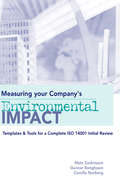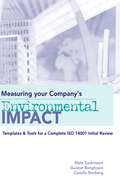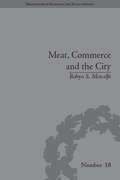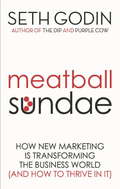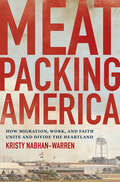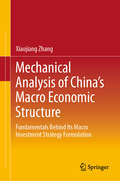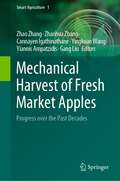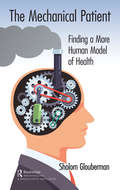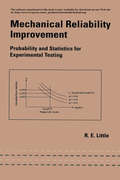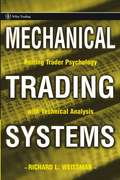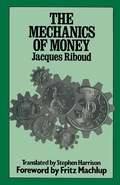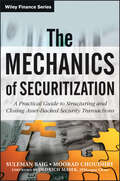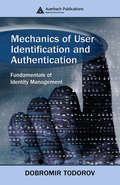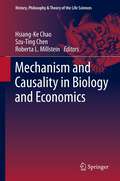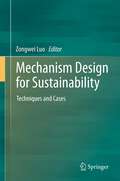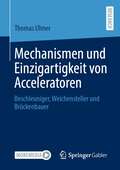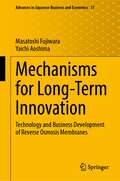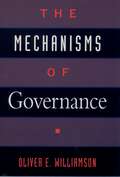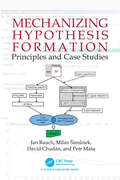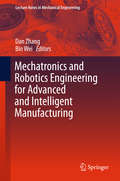- Table View
- List View
Measuring Your Company's Environmental Impact: Templates and Tools for a Complete ISO 14001 Initial Review
by Camilla Astrand Mats Zackrisson Gunnar BengtssonISO 14001 and EMAS (the Eco-Management and Audit Scheme) requirements can be daunting for managers and expensive for companies. How to Measure your Company's Environmental Impact is the most cost-effective and easy-to-use environmental review solution for companies in all sectors of the economy. Designed and written by top environmental engineers, and used by top consultants and companies in Europe, this step-by-step manual contains extensive tools for managers to carry out a complete company-wide initial environmental review as a prerequisite for introducing an environmental management system in accordance with ISO 14001 or EMAS. Emphasis is placed on collecting and presenting quantitative data, starting with material and energy flows through the company. The manual provides indicators for energy, transportation and water use, against which to measure your company. The complimentary CD-ROM toolkit includes a template for the environmental review, an inventory tool designed to calculate emissions and the environmental impact of your company's transportation, energy consumption and other activities, and instructions and forms for an environmental failure mode and effects analysis (FMEA) - a method for identifying and evaluating environmental impact to determine your company's most significant environmental aspects.
Measuring Your Company's Environmental Impact: Templates and Tools for a Complete ISO 14001 Initial Review
by Camilla Astrand Mats Zackrisson Gunnar BengtssonISO 14001 and EMAS (the Eco-Management and Audit Scheme) requirements can be daunting for managers and expensive for companies. How to Measure your Company's Environmental Impact is the most cost-effective and easy-to-use environmental review solution for companies in all sectors of the economy. Designed and written by top environmental engineers, and used by top consultants and companies in Europe, this step-by-step manual contains extensive tools for managers to carry out a complete company-wide initial environmental review as a prerequisite for introducing an environmental management system in accordance with ISO 14001 or EMAS. Emphasis is placed on collecting and presenting quantitative data, starting with material and energy flows through the company. The manual provides indicators for energy, transportation and water use, against which to measure your company. The complimentary CD-ROM toolkit includes a template for the environmental review, an inventory tool designed to calculate emissions and the environmental impact of your company's transportation, energy consumption and other activities, and instructions and forms for an environmental failure mode and effects analysis (FMEA) - a method for identifying and evaluating environmental impact to determine your company's most significant environmental aspects.
Meat, Commerce and the City: The London Food Market, 1800–1855 (Perspectives in Economic and Social History)
by Robyn S MetcalfeThis study examines the struggle between Smithfield market's supporters and detractors and argues that this demonstrates a major shift in the way the urban landscape came to be used.
Meat, Commerce and the City: The London Food Market, 1800–1855 (Perspectives in Economic and Social History #18)
by Robyn S MetcalfeThis study examines the struggle between Smithfield market's supporters and detractors and argues that this demonstrates a major shift in the way the urban landscape came to be used.
Meatball Sundae: How new marketing is transforming the business world (and how to thrive in it)
by Seth GodinWhat is a meatball sundae? It's something messy, disgusting and ineffective, the result of combining two perfectly good things that don't go together. Meatballs are the basic staples, the things people need, the stuff that used to be marketed quite well with TV and other mass market techniques. The topping is new marketing: MySpace, websites, YouTube, and all of the magic that CEOs wish would shine atop their companies. The problem? New marketing is lousy at selling meatballs. When confronted with the myriad opportunities presented by new marketing, people usually ask 'How can we make this stuff work for us?' This, as Seth Godin explains in his remarkable new book, is exactly the wrong question. Mapping out 14 trends that are completely remaking what it means to be a marketer - and by extension transforming what we make and how we make it - Godin shows how the question for any thriving 21st century business must be: 'How can we alter our business to become an organization that thrives on new marketing?' Meatball Sundae is an essential guide to the fundamental shift taking place in the marketing and business world, and shows you how to align your business to it.
Meatpacking America: How Migration, Work, and Faith Unite and Divide the Heartland
by Kristy Nabhan-WarrenWhether valorized as the heartland or derided as flyover country, the Midwest became instantly notorious when COVID-19 infections skyrocketed among workers in meatpacking plants—and Americans feared for their meat supply. But the Midwest is not simply the place where animals are fed corn and then butchered. Native midwesterner Kristy Nabhan-Warren spent years interviewing Iowans who work in the meatpacking industry, both native-born residents and recent migrants from Latin America, Africa, and Asia. In Meatpacking America, she digs deep below the stereotype and reveals the grit and grace of a heartland that is a major global hub of migration and food production—and also, it turns out, of religion. Across the flatlands, Protestants, Catholics, and Muslims share space every day as worshippers, employees, and employers. On the bloody floors of meatpacking plants, in bustling places of worship, and in modest family homes, longtime and newly arrived Iowans spoke to Nabhan-Warren about their passion for religious faith and desire to work hard for their families. Their stories expose how faith-based aspirations for mutual understanding blend uneasily with rampant economic exploitation and racial biases. Still, these new and old midwesterners say that a mutual language of faith and morals brings them together more than any of them would have ever expected.
Mechanical Analysis of China's Macro Economic Structure: Fundamentals Behind Its Macro Investment Strategy Formulation
by Xiaojiang ZhangThis volume is a major breakthrough in helping decipher and piece together the major interactive and flow investment dynamics within the complex Chinese economic structure, in an effort to guide global investors to formulate their own macro assessment and investment strategy in or related to China. Different from US that had a relatively short and ascending economic past, China endured a much longer history with quite a few volatile economic cycles. With that lesson of history in the background as the country’s guiding management principle, China’s economic policy and management superstructure, combined with regional government, business, consumer and investment community, form together a huge and complex operating environment of investment flow dynamics within which macro investment opportunities can be identified and strategies can be formulated by interested global and domestic investors..
Mechanical Harvest of Fresh Market Apples: Progress over the Past Decades (Smart Agriculture #1)
by Zhao Zhang Zhaohua Zhang Cannayen Igathinathane Yingkuan Wang Yiannis Ampatzidis Gang LiuThis book presents the progress, changes, and evolvement for apple mechanical harvest during the past decades, which include, but not limited to, bulky harvest method, harvest platform, apple infield sorting, and harvest robotics. Though there are significant progresses in apple harvest robotics, there still is a long way ahead before its practical applications, with existing and potential bottlenecks described in this book. Hence, other researchers would take advantage of this book to have a hint of the apple mechanical harvest history and state-of-the-art progress, so that they can find the room for their new research. This book targets senior undergraduates and more importantly graduate students in the field of agricultural engineering, sensing, automatic, and robotics.
The Mechanical Patient: Finding a More Human Model of Health
by Sholom GloubermanHealthcare is very much dependent on the model of the patient that is assumed by healthcare providers. The current model derives from a chemical/mechanical view of the patient body. Simply put: we are healthy if all of our mechanical parts are working properly and if all of the chemicals in our body are in the right proportions and have the appropriate reactions. This view is based on philosophical accounts of the body that go back to Paracelsus, Descartes, Boyle and others. It became the central basis of medical practice only in the late 19th Century after several hundred years of research and professional politics. The Mechanical Patient traces the intellectual development of the chemical/mechanical model of the patient and its implementation. This book names the problem that we have with the mechanical patient and prepares us to respond to its exaggerated place in our society. It provides a historical and conceptual background and explains how the chemical/mechanical model of health gained such a strong hold over our thinking and took the place of the earlier Galenic humoral model. It sketches a promising outline of a more humanized model for understanding health and calls for help to fully articulate it. In that way, it joins a growing movement to go beyond our current chemical/mechanical orientation.
The Mechanical Patient: Finding a More Human Model of Health
by Sholom GloubermanHealthcare is very much dependent on the model of the patient that is assumed by healthcare providers. The current model derives from a chemical/mechanical view of the patient body. Simply put: we are healthy if all of our mechanical parts are working properly and if all of the chemicals in our body are in the right proportions and have the appropriate reactions. This view is based on philosophical accounts of the body that go back to Paracelsus, Descartes, Boyle and others. It became the central basis of medical practice only in the late 19th Century after several hundred years of research and professional politics. The Mechanical Patient traces the intellectual development of the chemical/mechanical model of the patient and its implementation. This book names the problem that we have with the mechanical patient and prepares us to respond to its exaggerated place in our society. It provides a historical and conceptual background and explains how the chemical/mechanical model of health gained such a strong hold over our thinking and took the place of the earlier Galenic humoral model. It sketches a promising outline of a more humanized model for understanding health and calls for help to fully articulate it. In that way, it joins a growing movement to go beyond our current chemical/mechanical orientation.
Mechanical Reliability Improvement: Probability and Statistics for Experimental Testing
by Robert LittleProviding probability and statistical concepts developed using pseudorandom numbers, this book covers enumeration-, simulation-, and randomization-based statistical analyses for comparison of the test performance of alternative designs, as well as simulation- and randomization-based tests for examination of the credibility of statistical presumptio
Mechanical Trading Systems: Pairing Trader Psychology with Technical Analysis (Wiley Trading #242)
by Richard L. WeissmanA wide variety of flexible trading systems that combine sophisticated technical analysis with trading psychology theory Mechanical Trading Systems examines the development process for choosing and using mechanical trading systems in conjunction with trader psychology. This book discusses the advantages and disadvantages of mechanical trading systems; the dangers in system development and how to avoid them; the optimal methods for back-testing trading systems; position sizing and other risk quantification tools; and methods of improving rates of return on investments without significantly increasing risk. Most importantly, through a detailed examination of various types of unsuccessful trader personality traits (e.g., fearfulness, greed, and impatience), the book recommends different types of trading systems for a diverse array of trader types. Richard L. Weissman (Port Richey, FL) has seventeen years' experience as a trader and developer of trading systems. He currently provides independent consultation an d training services to traders and risk management professionals in the areas of technical analysis, risk management, and trader psychology.
The Mechanics of Securitization: A Practical Guide to Structuring and Closing Asset-Backed Security Transactions (Wiley Finance #193)
by Moorad ChoudhryA step-by-step guide to implementing and closing securitization transactions Securitization is still in wide use despite the reduction in transactions. The reality is that investors and institutions continue to use this vehicle for raising funds and the demand for their use will continue to rise as the world's capital needs increase. The Mechanics of Securitization specifically analyzes and describes the process by which a bank successfully implements and closes a securitization transaction in the post subprime era. This book begins with an introduction to asset-backed securities and takes you through the historical impact of these transactions including the implications of the recent credit crisis and how the market has changed. Discusses, in great detail, rating agency reviews, liaising with third parties, marketing the deals, and securing investors Reviews due diligence and cash flow analysis techniques Examines credit and cash considerations as well as how to list and close deals Describes the process by which a bank will structure and implement the deal, and how the process is project managed and tested across internal bank departments While securitization transactions have been taking place for over twenty-five years, there is still a lack of information on exactly how they are processed successfully. This book will put you in a better position to understand how it all happens, and show you how to effectively implement an ABS transaction yourself.
The Mechanics of Securitization: A Practical Guide to Structuring and Closing Asset-Backed Security Transactions (Wiley Finance #193)
by Moorad ChoudhryA step-by-step guide to implementing and closing securitization transactions Securitization is still in wide use despite the reduction in transactions. The reality is that investors and institutions continue to use this vehicle for raising funds and the demand for their use will continue to rise as the world's capital needs increase. The Mechanics of Securitization specifically analyzes and describes the process by which a bank successfully implements and closes a securitization transaction in the post subprime era. This book begins with an introduction to asset-backed securities and takes you through the historical impact of these transactions including the implications of the recent credit crisis and how the market has changed. Discusses, in great detail, rating agency reviews, liaising with third parties, marketing the deals, and securing investors Reviews due diligence and cash flow analysis techniques Examines credit and cash considerations as well as how to list and close deals Describes the process by which a bank will structure and implement the deal, and how the process is project managed and tested across internal bank departments While securitization transactions have been taking place for over twenty-five years, there is still a lack of information on exactly how they are processed successfully. This book will put you in a better position to understand how it all happens, and show you how to effectively implement an ABS transaction yourself.
Mechanics of User Identification and Authentication: Fundamentals of Identity Management
by Dobromir TodorovUser identification and authentication are essential parts of information security. Users must authenticate as they access their computer systems at work or at home every day. Yet do users understand how and why they are actually being authenticated, the security level of the authentication mechanism that they are using, and the potential impacts o
Mechanism and Causality in Biology and Economics (History, Philosophy and Theory of the Life Sciences #3)
by Hsiang-Ke Chao, Szu-Ting Chen and Roberta L. MillsteinThis volume addresses fundamental issues in the philosophy of science in the context of two most intriguing fields: biology and economics. Written by authorities and experts in the philosophy of biology and economics, Mechanism and Causality in Biology and Economics provides a structured study of the concepts of mechanism and causality in these disciplines and draws careful juxtapositions between philosophical apparatus and scientific practice. By exploring the issues that are most salient to the contemporary philosophies of biology and economics and by presenting comparative analyses, the book serves as a platform not only for gaining mutual understanding between scientists and philosophers of the life sciences and those of the social sciences, but also for sharing interdisciplinary research that combines both philosophical concepts in both fields.The book begins by defining the concepts of mechanism and causality in biology and economics, respectively. The second and third parts investigate philosophical perspectives of various causal and mechanistic issues in scientific practice in the two fields. These two sections include chapters on causal issues in the theory of evolution; experiments and scientific discovery; representation of causal relations and mechanism by models in economics. The concluding section presents interdisciplinary studies of various topics concerning extrapolation of life sciences and social sciences, including chapters on the philosophical investigation of conjoining biological and economic analyses with, respectively, demography, medicine and sociology.
Mechanism Design for Sustainability: Techniques and Cases
by Zongwei LuoThis book provides advanced analytics and decision management techniques and tools for developing sustainable competitive advantages in the studied target context. In order to achieve sustainable economy, “the capacity to endure,” it is essential to understand and study the mechanisms for interactions and impact from and among these perspectives.
Mechanismen und Einzigartigkeit von Acceleratoren: Beschleuniger, Weichensteller und Brückenbauer
by Thomas UlmerAcceleratoren sind ein neues, schnell wachsendes Element in unternehmerischen Ökosystemen und trotz ihrer erst kurzen Geschichte weit verbreitet. Das Wissen über die Auswirkungen von Acceleratoren auf die Entwicklung der teilnehmenden Start-ups ist jedoch nach wie vor begrenzt. Thomas Ulmer hat mit Hilfe eines qualitativen Forschungsdesigns, basierend auf 21 Interviews, die wertsteigernden Mechanismen von Acceleratoren aus Sicht von Gründern untersucht. Dabei zeigt sich erstens, dass Acceleratoren jeden Schritt der Ressourcenmobilisierung erleichtern, indem sie Unsicherheiten reduzieren und Defizite der Gründer und Start-ups kompensieren. Zweitens wird der Gründungsprozess durch Acceleratoren auch besser strukturiert, da die Teilnehmer eine Gründeridentität aufbauen und der Gründungsprozess selbst professionalisiert wird. Schließlich unterstützen Acceleratoren Start-ups beim Aufbau einer Ressourcenbasis, indem sie zum einen Ressourcen unmittelbar bereitstellen und zum anderen Brücken zur Akquise verschiedener Ressourcen schlagen. Neben diesem theoretischen Erkenntnisgewinn können auch eine Reihe von Praxisimplikationen abgeleitet werden, die die Arbeit für Gründer, Manager von Acceleratoren und Entscheidungsträger der Politik interessant machen.
Mechanisms for Long-Term Innovation: Technology and Business Development of Reverse Osmosis Membranes (Advances in Japanese Business and Economics #31)
by Masatoshi Fujiwara Yaichi AoshimaThis book explores how a long-term innovation can take place based on historical analyses of the development of reverse osmosis (RO) membrane from the early 1950s to the mid-2010s. The RO membrane is a critical material for desalination that is a key to solve water shortages becoming serious in many places of the world. The authors conducted in-depth field studies as well as analyses of rich archival data to demonstrate how researchers, engineers, managers, entrepreneurs, and policymakers interacted each other for this material innovation to be realized. A series of historical analyses in this book uncovered that initial government supports, strategic niche markets, emergence of breakthrough technology, and company-specific rationales played significant roles for companies to overcome four types of uncertainty, technological, market, competition, and social/organizational ones, and enabled the companies to persistently invest in the development and commercialization of the RO membrane. This book depicts that innovation does not arise on a sudden, but that it is actualized through long lasting process with turns and twists, which is driven by many non-economic rationales beyond economic motives.
The Mechanisms of Governance
by Oliver E. WilliamsonThis book brings together in one place the work of one of our most respected economic theorists, on a field in which he has played a large part in originating: the New Institutional Economics. Transaction cost economics, which studies the governance of contractual relations, is the branch of the New Institutional Economics with which Oliver Williamson is especially associated. Transaction cost economics takes issue with one of the fundamental building blocks in microeconomics: the theory of the firm. Whereas orthodox economics describes the firm in technological terms, as a production function, transaction cost economics describes the firm in organizational terms, as a governance structure. Alternative feasible forms of organization--firms, markets, hybrids, bureaus--are examined comparatively. The analytical action resides in the details of transactions and the mechanisms of governance. Transaction cost economics has had a pervasive influence on current economic thought about how and why institutions function as they do, and it has become a practical framework for research in organizations by representatives of a variety of disciplines. Through a transaction cost analysis, The Mechanisms of Governance shows how and why simple contracts give way to complex contracts and internal organization as the hazards of contracting build up. That complicates the study of economic organization, but a richer and more relevant theory of organization is the result. Many testable implications and lessons for public policy accrue to this framework. Applications of both kinds are numerous and growing. Written by one of the leading economic theorists of our time, The Mechanisms of Governance is sure to be an important work for years to come. It will be of interest to scholars and students of economics, organization, management, and law.
The Mechanisms of Governance
by Oliver E. WilliamsonThis book brings together in one place the work of one of our most respected economic theorists, on a field in which he has played a large part in originating: the New Institutional Economics. Transaction cost economics, which studies the governance of contractual relations, is the branch of the New Institutional Economics with which Oliver Williamson is especially associated. Transaction cost economics takes issue with one of the fundamental building blocks in microeconomics: the theory of the firm. Whereas orthodox economics describes the firm in technological terms, as a production function, transaction cost economics describes the firm in organizational terms, as a governance structure. Alternative feasible forms of organization--firms, markets, hybrids, bureaus--are examined comparatively. The analytical action resides in the details of transactions and the mechanisms of governance. Transaction cost economics has had a pervasive influence on current economic thought about how and why institutions function as they do, and it has become a practical framework for research in organizations by representatives of a variety of disciplines. Through a transaction cost analysis, The Mechanisms of Governance shows how and why simple contracts give way to complex contracts and internal organization as the hazards of contracting build up. That complicates the study of economic organization, but a richer and more relevant theory of organization is the result. Many testable implications and lessons for public policy accrue to this framework. Applications of both kinds are numerous and growing. Written by one of the leading economic theorists of our time, The Mechanisms of Governance is sure to be an important work for years to come. It will be of interest to scholars and students of economics, organization, management, and law.
Mechanizing Hypothesis Formation: Principles and Case Studies
by Jan Rauch Milan Šimůnek David Chudán Petr MášaMechanizing hypothesis formation is an approach to exploratory data analysis. Its development started in the 1960s inspired by the question “can computers formulate and verify scientific hypotheses?”. The development resulted in a general theory of logic of discovery. It comprises theoretical calculi dealing with theoretical statements as well as observational calculi dealing with observational statements concerning finite results of observation. Both calculi are related through statistical hypotheses tests. A GUHA method is a tool of the logic of discovery. It uses a one-to-one relation between theoretical and observational statements to get all interesting theoretical statements. A GUHA procedure generates all interesting observational statements and verifies them in a given observational data. Output of the procedure consists of all observational statements true in the given data. Several GUHA procedures dealing with association rules, couples of association rules, action rules, histograms, couples of histograms, and patterns based on general contingency tables are involved in the LISp-Miner system developed at the Prague University of Economics and Business. Various results about observational calculi were achieved and applied together with the LISp-Miner system. The book covers a brief overview of logic of discovery. Many examples of applications of the GUHA procedures to solve real problems relevant to data mining and business intelligence are presented. An overview of recent research results relevant to dealing with domain knowledge in data mining and its automation is provided. Firsthand experiences with implementation of the GUHA method in the Python language are presented.
Mechanizing Hypothesis Formation: Principles and Case Studies
by Jan Rauch Milan Šimůnek David Chudán Petr MášaMechanizing hypothesis formation is an approach to exploratory data analysis. Its development started in the 1960s inspired by the question “can computers formulate and verify scientific hypotheses?”. The development resulted in a general theory of logic of discovery. It comprises theoretical calculi dealing with theoretical statements as well as observational calculi dealing with observational statements concerning finite results of observation. Both calculi are related through statistical hypotheses tests. A GUHA method is a tool of the logic of discovery. It uses a one-to-one relation between theoretical and observational statements to get all interesting theoretical statements. A GUHA procedure generates all interesting observational statements and verifies them in a given observational data. Output of the procedure consists of all observational statements true in the given data. Several GUHA procedures dealing with association rules, couples of association rules, action rules, histograms, couples of histograms, and patterns based on general contingency tables are involved in the LISp-Miner system developed at the Prague University of Economics and Business. Various results about observational calculi were achieved and applied together with the LISp-Miner system. The book covers a brief overview of logic of discovery. Many examples of applications of the GUHA procedures to solve real problems relevant to data mining and business intelligence are presented. An overview of recent research results relevant to dealing with domain knowledge in data mining and its automation is provided. Firsthand experiences with implementation of the GUHA method in the Python language are presented.
Mechatronics and Robotics Engineering for Advanced and Intelligent Manufacturing (Lecture Notes in Mechanical Engineering)
by Dan Zhang Bin WeiFeaturing selected contributions from the 2nd International Conference on Mechatronics and Robotics Engineering, held in Nice, France, February 18–19, 2016, this book introduces recent advances and state-of-the-art technologies in the field of advanced intelligent manufacturing. This systematic and carefully detailed collection provides a valuable reference source for mechanical engineering researchers who want to learn about the latest developments in advanced manufacturing and automation, readers from industry seeking potential solutions for their own applications, and those involved in the robotics and mechatronics industry.
